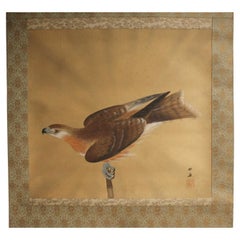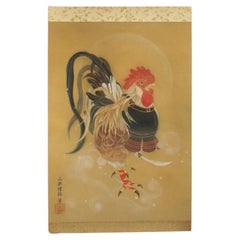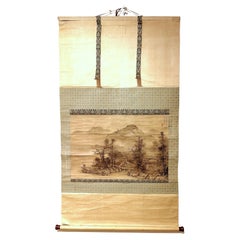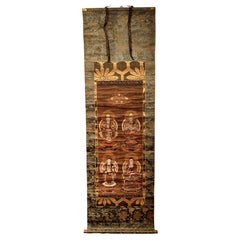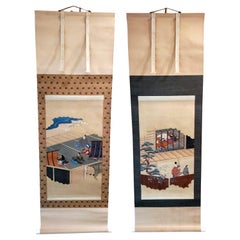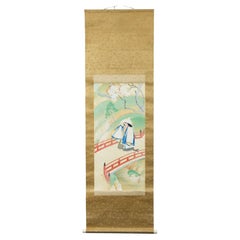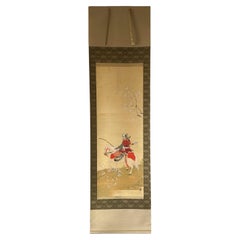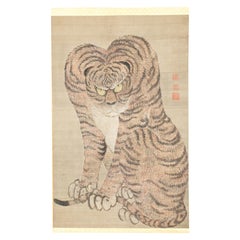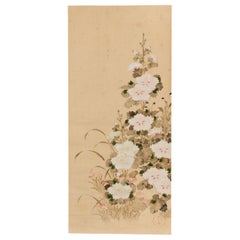Japanese Scroll Art
Antique 19th Century Japanese Paintings and Screens
Silk
21st Century and Contemporary Japanese Paintings and Screens
Silk
Antique 19th Century Japanese Paintings and Screens
Silk
Antique 19th Century Japanese Paintings and Screens
Paper
Antique Early 19th Century Japanese Japonisme Paintings and Screens
Brocade, Paper
Antique Mid-19th Century Japanese Meiji Paintings and Screens
Silk
20th Century Japanese Paintings and Screens
Wood, Paper
Antique Early 1800s Japanese Edo Paintings and Screens
Silk
Antique 19th Century Japanese Paintings and Screens
Silk, Wood, Paper
20th Century Japanese Paintings and Screens
Silk
Antique 19th Century Japanese Paintings and Screens
Silk
Early 20th Century Japanese Meiji Paintings and Screens
Paper
Antique Mid-19th Century Japanese Meiji Paintings and Screens
Silk
Antique 19th Century Japanese Paintings and Screens
Paper
20th Century Japanese Paintings and Screens
Wood, Paper
Antique Mid-19th Century Japanese Meiji Paintings and Screens
Silk
Antique Mid-19th Century Japanese Meiji Paintings and Screens
Silk
Antique Mid-19th Century Japanese Meiji Paintings and Screens
Silk
Antique Early 1900s Japanese Meiji Paintings and Screens
Paper
Antique 1890s Japanese Meiji Paintings and Screens
Paper
Antique Early 19th Century Japanese Edo Paintings and Screens
Silk
Vintage 1940s Japanese Paintings and Screens
Paper
Antique 19th Century Japanese Meiji Paintings and Screens
Bronze
Antique 19th Century Japanese Edo Paintings and Screens
Silk, Paper
Early 20th Century Japanese Taisho Paintings and Screens
Silk
Antique Early 17th Century Japanese Japonisme Paintings and Screens
Silk, Paper
Antique 19th Century Japanese Paintings and Screens
Silk
Antique Early 19th Century Japanese Textiles
Paper
20th Century Japanese Paintings and Screens
Silk
Antique 1840s Japanese Edo Paintings and Screens
Silk
20th Century Japanese Paintings and Screens
Fabric, Silk
Antique Late 19th Century Japanese Meiji Paintings and Screens
Silk
Antique Late 17th Century Japanese Japonisme Paintings and Screens
Wood, Paper
20th Century Japanese Taisho Paintings and Screens
Wood, Paper
Antique 19th Century Japanese Paintings and Screens
Silk
20th Century Japanese Paintings and Screens
Silk
Antique 19th Century Japanese Paintings and Screens
Paint
Antique 1810s Japanese Edo Paintings and Screens
Paper
Antique 18th Century Japanese Edo Paintings and Screens
Silk, Paper
Antique 18th Century Japanese Japonisme Paintings and Screens
Silk, Paper
20th Century Japanese Showa Paintings and Screens
Fabric
20th Century Japanese Taisho Paintings and Screens
Silk
Antique Early 1900s Japanese Japonisme Paintings and Screens
Brocade, Silk, Paper
Antique Early 19th Century Japanese Edo Paintings and Screens
Silk, Paper
20th Century Japanese Showa Paintings and Screens
Fabric
20th Century Japanese Meiji Paintings and Screens
Bronze
Antique Early 19th Century Japanese Edo Paintings and Screens
Silk
Antique 19th Century Japanese Paintings and Screens
Paper
Antique Mid-19th Century Japanese Meiji Paintings and Screens
Silk
Early 20th Century Japanese Taisho Paintings and Screens
Wood, Paper
Antique 19th Century Japanese Meiji Paintings and Screens
Silk
Early 20th Century Japanese Taisho Paintings and Screens
Silk
Antique 19th Century Japanese Meiji Metalwork
Metal
20th Century Japanese Taisho Paintings and Screens
Silk
Vintage 1920s Japanese Japonisme Paintings and Screens
Silk
20th Century Japanese Taisho Paintings and Screens
Silk
Antique 19th Century Japanese Japonisme Paintings and Screens
Silk, Paper
- 1
Japanese Scroll Art For Sale on 1stDibs
How Much is a Japanese Scroll Art?
Finding the Right Paintings-screens for You
Traditional Asian paintings were often created on scrolls and folding screens. Artisans made screens that could be folded up or spread out by connecting several panels using hinges. Today, antique Asian folding screens and paintings are sophisticated decorative accents that can serve as makeshift partitions to ensure privacy.
The original folding screens were created by Chinese artists. The earliest record of screens comes from the 2nd century B.C., and surviving examples date back to the Ming dynasty. Chinese painting utilizes many of the same tools as calligraphy — these screens were crafted from wood with painted panels featuring striking art or calligraphy that told cultural stories or represented nature and life in the area.
The practice was introduced to Japan, where paintings for screens were made on paper and silk, in the 8th century. These paintings frequently feature subjects such as landscapes, animals, flowers and Buddhist religious themes. Along with screens for tea ceremonies and dance backgrounds, there were screens for use in Shinto and Buddhist temples.
In the 17th century, screens began to be imported to Europe where their popularity grew. Coco Chanel famously collected Coromandel folding screens.
Traditional Asian paintings can make a tasteful addition to any wall, and screens can be used as decoration or, in the case of larger iterations, as an aesthetic way to divide a large room. Browse the selection of antique Asian paintings and screens from a variety of styles and eras on 1stDibs.
- What are Japanese scrolls?1 Answer1stDibs ExpertApril 5, 2022Japanese scrolls are commonly called kakejiku, which means “hanging scroll” in English. Japanese scrolls are used to display paintings and calligraphy, and they boast a flexible backing for rollable storage. You can shop a collection of authentic Japanese scrolls from some of the world’s top sellers on 1stDibs.
- How do I hang a Japanese scroll?1 Answer1stDibs ExpertApril 5, 2022To hang a Japanese wall scroll, first install a nail or hook in the wall. Then, hold the screen in your non-dominant hand and use a forked bamboo stick or similar implement to grip the string attached to the top. Using the stick, lift the scroll onto the hook. Then, slowly unroll the scroll. On 1stDibs, shop a variety of Japanese wall scrolls.
- 1stDibs ExpertApril 5, 2022There are a variety of different types of Japanese art. One of the oldest and most admired forms of Japanese art is the art of calligraphy, which originated in the sixth or seventh century. Another type of art, ukiyo-e, is the art of the woodblock print, which depicts scenes of female beauties; kabuki actors, sumo wrestlers and more. You’ll find a variety of Japanese artwork from some of the world’s top art dealers on 1stDibs.
- 1stDibs ExpertApril 16, 2024The focus of Japanese art varies. Many traditional Japanese artists sought to capture the beauty of nature in their works. However, other Japanese artists have produced work with Buddhist themes, and contemporary artists working in the country have been inspired by a range of subjects, from socioeconomic and political issues to pop culture. On 1stDibs, explore a large selection of Japanese art.
- 1stDibs ExpertApril 5, 2022The writing on Japanese art is calligraphy art called shodo. It uses Japanese kanji and kana characters. There are a variety of different shodo styles of art, including Kaisho, which is the basic, foundational form of the art. On 1stDibs, find a range of Japanese calligraphy art from top sellers..
- 1stDibs ExpertSeptember 23, 2024What the Japanese sea art is called depends on its type. Many examples of sea art from Japan are called ukiyo-e. This term refers to woodblock prints made during the 17th, 18th and 19th centuries. The Great Wave off Kanagawa by Katsushika Hokusai is arguably the most famous ukiyo-e print depicting the sea. On 1stDibs, find a wide variety of Japanese woodblock prints.
- 1stDibs ExpertOctober 15, 2024To tell if art is Japanese or Chinese, study the piece's characteristics. With paintings, Chinese artists often use more color and tend to fill their entire canvases, while Japanese artists often include more negative space and choose subtler colors. There are also differences between the brushstrokes typical of traditional Chinese and Japanese art. In Japanese paintings, brushstrokes are often short and sharp. On the other hand, Chinese paintings often display longer, more fluid brushstrokes. Learning about the defining features of various art forms and periods and looking at examples of pieces made by Japanese and Chinese artists can help you learn to spot subtle differences. Explore a diverse assortment of Japanese and Chinese art on 1stDibs.
- 1stDibs ExpertApril 5, 2022Many art styles originated in Japan and grew in popularity over the years. Some of the most popular styles include shodo (calligraphy), ikebana, kanou and yamato-e. You’ll find a wide variety of authentic Japanese art from some of the world’s top dealers on 1stDibs.
- 1stDibs ExpertApril 5, 2022What Japanese wall art is called depends on its type. There are numerous kinds of Japanese paintings and prints, including nihonga and ukiyo-e. A Japanese wall scroll is known as a kakejiku or kakemono. On 1stDibs, find a variety of Japanese wall art.
Read More
Symbols of Happiness and Rebirth Adorn This Japanese Satsuma Bowl
Decorated with white cranes and the sought-after thousand-butterflies motif, the Meiji-period vessel offers both a celebration of traditional aesthetics and a clear reflection of the era’s appetite for exquisite export pieces.
Chicago’s Pagoda Red Has a Spirited Mix of Asian Antiques and Bold New Art
For 25 years, gallerist Betsy Nathan has leveraged her keen eye and key connections to bring a unique selection of rare finds to the market.
In L.A., Gallerist JF Chen Has Long Championed Eclectic Blue-Chip Design
Now working alongside his daughter Bianca, dealer Joel Chen has presented a most covetable array of antiques, art and contemporary creations for more than 40 years.
12 Calming Spaces Inspired by Japanese Design
From cherry-blossom-adorned walls paired with glamorous lighting to wood-paneled ceilings above checkerboard-patterned chairs, these 12 spaces seamlessly blend Eastern and Western aesthetics.
Rodrigo Rivero Lake’s Mexico City Showroom Is a Museum-Worthy Trove of Spanish Colonial and Asian Antiques
The dealer and curator has spent the past 50 years amassing a collection of exceptional art, furniture and architectural elements that trace the cultural influence of the Spanish empire from Europe to the Americas and beyond.
16 Refined Asian-Inspired Interiors
These spaces exemplify how Eastern elements elevate a home's decor.
